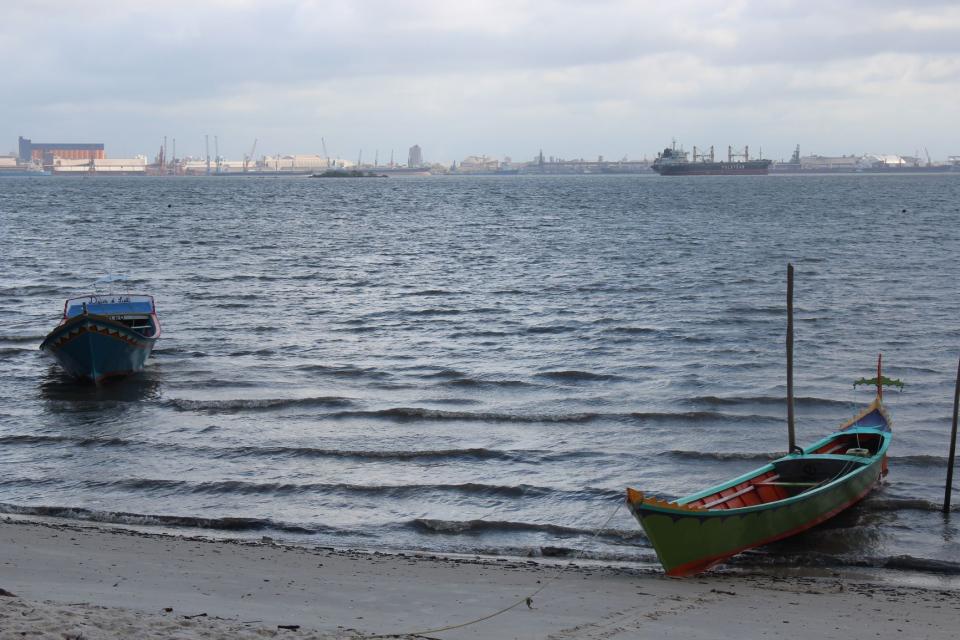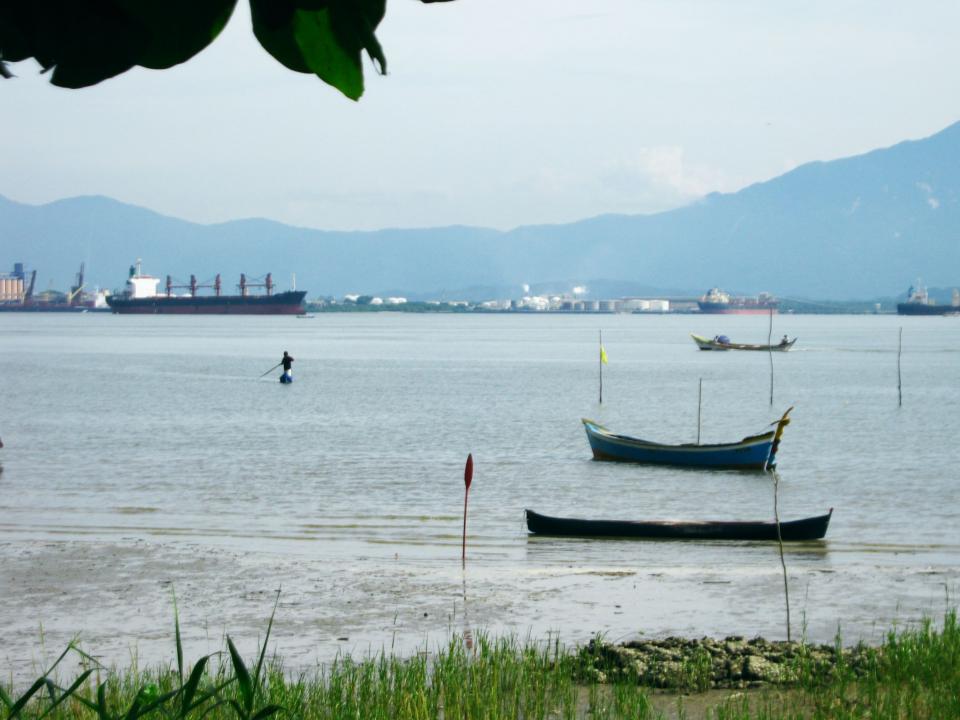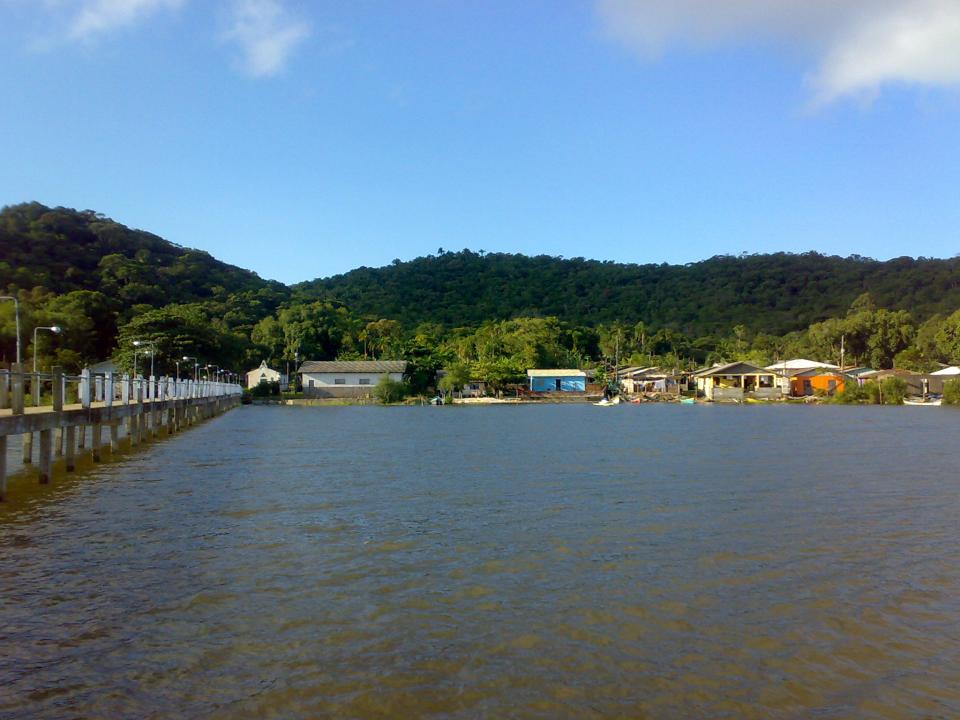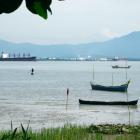On 15 November 2004, two explosions occurred in the Chilean ship Vicuña during a methanol unloading operation at the pier for dangerous goods at the Dom Pedro II Port, located in the city of Paranaguá, Brazil. After the explosion, the ship’s tanks ruptured, resulting in the leakage of bunker oil, diesel oil, and lubricating oil, for a total of approximately 285 tons. The leakage disaster caused the contamination of the coast ecosystems such as mangroves, sandbanks, and beaches. After this event, both fishing and the capture of shellfish and crustaceans were banned for approximately 60 days. A total of 36 fishing communities from the Paranaguá estuarine complex were affected by the fishing ban.

The coast of Amparo, 2014.
The coast of Amparo, 2014.
Photograph by Priscila Onório Figueira, 25 January 2014.
 This work is licensed under a Creative Commons Attribution 4.0 International License.
This work is licensed under a Creative Commons Attribution 4.0 International License.
The Vicuña ship accident was not an isolated event: together with similar incidents at the Port of Paranaguá, it was a part of a larger environmental disaster taking place over time. In 2001, there was a rupture of a Petrobras pipeline, which is a publicly traded company that drains oil derivatives and provides bunker oil to ships in the Port of Paranaguá. The rupture caused the leakage of four thousand liters of diesel oil, contaminating mangroves and swamps, also leading to a ban in fishing. Disasters involving pollution of oceans, rivers, and estuaries by the spill of oil derivatives are routine. In 2000, there was a leakage in a Petrobras pipeline in Rio de Janeiro, which spilled around 1.3 thousand tons of oil in the Guanabara Bay. This disaster is similar to Vicuña’s, since thousands of fishermen were harmed and are still claiming compensation today. In Latin America, ruptures in the Trans-Ecuadorian Pipeline System (SOTE) in the Ecuadorian Amazon region have been contaminating the Coca and Napo rivers for several years. Riverside and indigenous populations that depend on fishing are the most affected, living in a constant state of food emergencies.

A fisherman on the coast of Amparo, 2011.
A fisherman on the coast of Amparo, 2011.
Photograph by Priscila Onório Figueira, 26 March 2011.
 This work is licensed under a Creative Commons Attribution 4.0 International License.
This work is licensed under a Creative Commons Attribution 4.0 International License.
During the Vicuña disaster, palliative measures were created to assist affected fishermen. The companies Cattalini and P&I Club, the Ministry of Agriculture, and the shipowner subsidized basic food baskets. Cattalini paid half a minimum wage in a single installment for those workers registered at the Fishermen’s Colony. The Ministry of Labor paid for emergency unemployment insurance. The company KCL-Serviços Industriais claimed to have hired people from local communities to carry out cleaning services in the affected areas. In May 2005, the Laudo técnico do acidente do navio Vicuña [Technical report on the Vicuña ship accident] was published, bringing detailed information about the event, the main environmental impacts, and notices of infraction to the responsible companies. The technical report was written by two environmental agencies: IBAMA, which is a federal agency under the Ministry of Environment, and IAP, which is an agency linked to the Government of the State of Paraná.
The Amparo community was the place most affected by the oil contamination, being located in the city of Paranaguá and included in the Environmental Preservation Area of Guaraqueçaba. The location can only be accessed by sea. In 2014, approximately one hundred families lived in Amparo and the vast majority of them depend on artisanal fishing in order to not only obtain their income through the commercialization of fish, but also to complement their daily diet.
Interactive map showing the locations of the Dom Pedro II port and the Amparo community.
Through oral history interviews conducted between 2011 and 2014, the memories of fishermen who experienced the disaster were brought to light, enabling the discussion of issues not considered in the technical report. Fishermen did not remember the exact date or time at which the disaster occurred; the memories that first crossed their minds referred to the noise of explosions, and the image of fire, smoke, and oil that contaminated the beach of Amparo. They pointed out that black oil from the spill can still be found on beaches and mangroves. They also claimed that, after the disaster, there was a decrease in the number of some species of fish and crustaceans, such as shrimp, hake, and leatherjacket fish. Regarding the fishing ban period, the interviews demonstrated other issues. Retired fishermen remembered that they did not have the right to receive basic food baskets, emergency wages, and unemployment insurance, experiencing economic and food deprivation. They had to use their savings and ask for support from their family and neighbors in order to pay their bills and eat. Some of the interviewed fishermen worked on cleaning the beach and collecting oil and were not entitled to emergency unemployment insurance. This demonstrates that, due to economic deprivation and the delay in the payment of unemployment insurance, many fishermen accepted temporary employment.

The landing stage that gives access to Amparo community, 2010.
The landing stage that gives access to Amparo community, 2010.
Photograph by Priscila Onório Figueira, 30 April 2010.
 This work is licensed under a Creative Commons Attribution 4.0 International License.
This work is licensed under a Creative Commons Attribution 4.0 International License.

Photograph taken from another perspective showing the port of Paranaguá in the background, 2011.
Photograph taken from another perspective showing the port of Paranaguá in the background, 2011.
Photograph by Priscila Onório Figueira, 26 March 2011.
 This work is licensed under a Creative Commons Attribution 4.0 International License.
This work is licensed under a Creative Commons Attribution 4.0 International License.
The technical report on the Vicuña ship accident points out that long-term monitoring would be important in order to understand the dimension of the environmental impacts. However, there was no environmental monitoring after its publication. On the other hand, memories of fishermen emphasize the long-term impacts on the environment. Regarding the fined companies, unanswered questions still remain, for example, the case of the company Cattalini, which was fined fifty million Brazilian reais, equivalent to approximately ten million US dollars at the current value. The company avoided the fine by constructing a marine aquarium, worth five million Brazilian reais, a work that demonstrates the silence regarding the impacts of the environmental disaster, impacts that have not been redeemed. Disregarded, fishermen were “compensated” with measures that excluded them. Far beyond what has been described in this article, the sea means life for fishermen and, since the disaster caused changes in the sea, it also caused changes in their lives.
How to cite
Onório Figueira, Priscila. “Memories from the Disaster in 2004 of the Ship Vicuña.” Environment & Society Portal, Arcadia (Spring 2021), no. 7. Rachel Carson Center for Environment and Society. doi:10.5282/rcc/9228.
ISSN 2199-3408
Environment & Society Portal, Arcadia
 This work is licensed under a Creative Commons Attribution 4.0 International License.
This work is licensed under a Creative Commons Attribution 4.0 International License.
2021 Priscila Onório Figueira
This refers only to the text and does not include any image rights.
Please click on an image to view its individual rights status
- Acselrad, Henri, and Cecília Mello. “Conflito social e risco ambiental: o caso de um vazamento de óleo na Baía de Guanabara.” In Ecología Política: Naturaleza, sociedad y utopia, edited by Héctor Alimonda, 293–317. Buenos Aires: CLACSO, 2002.
- Diegues, Antônio Carlos. “The Mata Atlantica Biosphere Reserve (RBMA): An Overview.” Unpublished working paper, South-South Cooperation Programme on Environmentally Sound Socio-Economic Development in the Humid Tropics, UNESCO, Paris, 1995.
- Figueira, Priscila. “Memórias do desastre ambiental do navio Vicuña (2004).” Faces da História 6, no. 1 (2019): 120–40.
- Instituto Ambiental do Paraná (IAP) and Acervo do Instituto Brasileiro do Meio Ambiente e dos Recursos Naturais Renováveis (IBAMA). Laudo técnico do acidente do navio Vicuña, ocorrido em Paranaguá no dia 15 de novembro de 2004. Brasília: IBAMA, 2005.
- Noernberg, Mauricio A., Rangel Angelotti, Guilherme A. Caldeira, and A. F. Ribeiro de Sousa. “Determinação da sensibilidade do litoral paranaense à contaminação por óleo.” Brazilian Journal of Aquatic Science and Technology 12, no. 2 (2008): 49–59.
- Pollak, Michael. “Memória, Esquecimento e Silêncio.” Estudos Históricos 2, no. 3 (1989): 3–15.
- Pontes, Nádia. “Vazamento de petróleo coloca em risco indígenas no Equador.” Deustche Welle, 4 May 2020.








